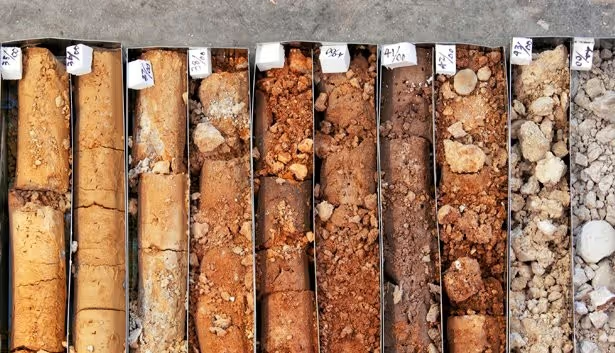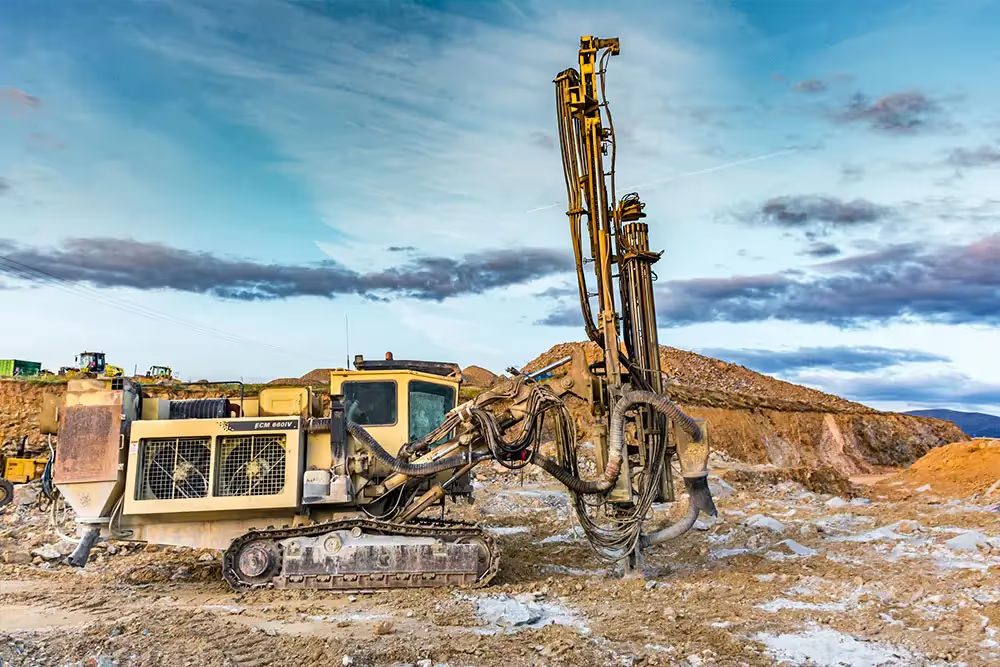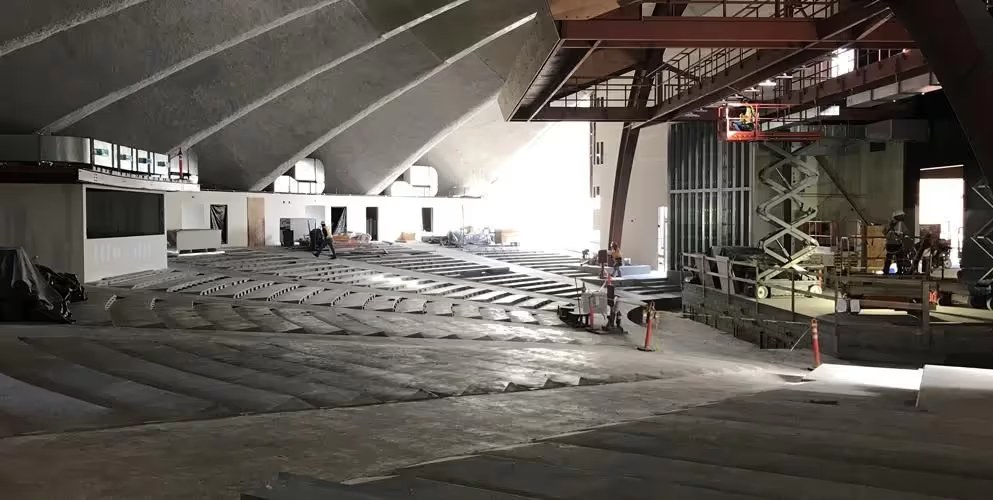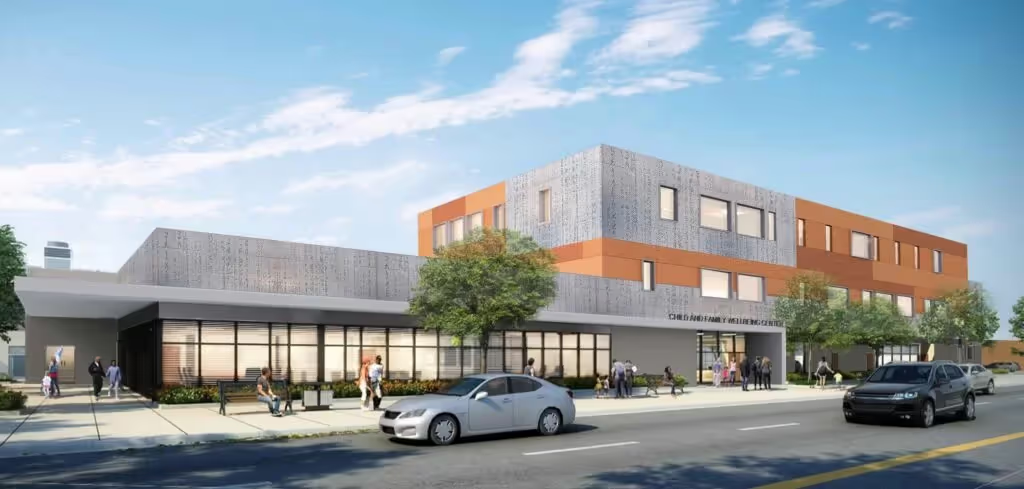

Geotechnical Engineering Services
Laying the foundation for safe and sustainable construction
Twining’s geotechnical engineers, geologists, and technicians bring their finest professional skills and practical experience to each project. Because we regularly provide both quality assurance and quality control services for geotechnical engineering design, we have unique and valuable insight into what it takes to get a job done efficiently and cost-effectively.
Our experts develop geotechnical services and investigation programs that include field exploration and laboratory testing to evaluate the subsurface conditions at a wide variety of sites. Typical field investigation methods include:
- small and large diameter borings
- cone penetration testing
- down-hole logging
- installation of monitoring wells
- trenching for geological/seismological hazards and fault investigations
- Laboratory trial batch of concrete (ASTM C192)
- Concrete setting time (ASTM C403)
- Slump flow of self-consolidating concrete (ASTM C1611)
- Passing ability of self-consolidating concrete by J-ring (ASTM C1621)
- Static segregation of self-consolidating concrete (ASTM C1610)
- Bleeding of concrete (ASTM C232)
- Compressive strength (ASTM C39)
- Flexural strength (ASTM C78)
- Splitting tensile strength (ASTM C496)
- Static modulus of elasticity (ASTM C469)
- Drying shrinkage (ASTM C157, AASHTO T160)Restrained expansion (ASTM C878)
- Coefficient of thermal expansion (AASHTO T336, CRD 39)
- Flexural toughness of fiber-reinforced concrete (ASTM C1609, EN 14651)
- Tensile performance of fiber-reinforced concrete using double-punch loading (Draft ASTM)
- Cracking resistance (ASTM C1581)
- Creep (ASTM C512)
- Water-soluble chloride (ASTM C1218)
- Acid-soluble chloride (ASTM C1152)
- Rapid chloride permeability (ASTM C1202)
- Chloride diffusion coefficient (ASTM C1556, NT Build 492)Concrete formation factor (AASHTO 358)Density, absorption, and voids in hardened concrete (ASTM C642)
- Bulk electrical resistivity of concrete (ASTM C1876)
- Surface electrical resistivity of concrete (AASHTO TP95)
- Density of structural lightweight concrete made in the laboratory, equilibrium or oven dry method (ASTM C567)
- Laboratory development of strength-maturity curve (ASTM C1074)
- Petrographic exam on hardened concrete (ASTM C856, ASTM C1723)
- Air void systems in hardened concrete (ASTM C457)
- W/CM determination (NT Build 361)
- Insoluble residue analysis (ASTM C1324)
- Portland cement (ASTM C150)
- Portland limestone cement and other blended hydraulic cement (ASTM C595)
- Shrinkage-compensating cement (ASTM C845)
- Other hydraulic cement (ASTM C1157)
- Rapid hardening hydraulic cement (ASTM C1600)
- Plastic (stucco) cement (ASTM C1328)
- Fly ash and natural pozzolan (ASTM C618)
- Slag cement (ASTM C989)
- Silica fume (ASTM C1240)
- Alternative supplementary cementitious materials (ASTM C1709)
- Restrained expansion of Type K cement mortar (ASTM C806)
- Sulfate resistance of hydraulic cement (ASTM C1012)
- Sulfate resistance of Portland cement (ASTM C452)
- Expansion of hydraulic cement mortar in water (ASTM C1038)
- Effectiveness of Pozzolan & Slag Cement in Mitigating Expansion due to ASR (ASTM C441)
- Abrasion resistance (ASTM C131)
- Clay lumps and friable particles (ASTM C142)
- Cleanness value (CTM 227)
- Chloride and sulfate content (CTM 417, CTM 422)
- Crushed/fractured particles (ASTM D5821, CTM 205)
- Durability Index (ASTM D3744, CTM 229)
- Fine aggregates angularity (ASTM C1252, CTM 234, AASHTO T304)
- Flat and elongated particles (ASTM D4791)
- Moisture content of soil or rock (ASTM D2216, CTM 226)
- R Value (ASTM D2844, CTM 217)
- Sieve analysis (ASTM C136, CTM 202)
- No. 200 wash (ASTM D1140, CTM 202)
- Sieve with Hydrometer (ASTM D422, D7928, CTM 203)
- Soundness (ASTM C88)
- Specific gravity and absorption (ASTM C127, ASTM C128)
- Swell/Settlement potential (ASTM D4546)
- Bulk density and voids in aggregates (ASTM C29, CTM 212)
- Lightweight particles in aggregates (ASTM C123)
- Evaluation of alkali-silica reactivity of aggregates and aggregate-cementitious combinations (ASTM C1260, ASTM C289, ASTM C1293, ASTM C1567, ASTM C1778)
- Qualification of aggregates for use in concrete (ASTM C33)
- Qualification of lightweight aggregates for use in concrete (ASTM C330)
- Qualification of concrete aggregates per requirements of Caltrans, Greenbook, FAA, and other agencies
- Aggregate certification for deleterious materials per USACE scope
- Petrographic examination of aggregates (ASTM C295)
- Scratch hardness of aggregates (CRD-C 130)
- Resistance of rock to freezing and thawing (CRD-C 144)
- Chemical admixtures for concrete (ASTM C494)
- Air-entraining admixtures for concrete (ASTM C260)
- Mortar for unit masonry (ASTM C270)
- Packaged Dry, Hydraulic-Cement Grout Non-shrink (ASTM C1107)
- Packaged, Dry, Rapid-Hardening Cementitious Materials for Concrete Repairs (ASTM C928)
- Mortars for plain and reinforced unit masonry (ASTM C780)
- Sampling and testing grout for masonry (ASTM C1019)
- Non-shrink grout: height change after final set (ASTM C1090)
- None-shrink grout: height change at early age (ASTM C827)
- Compressive strength of mortar cubes (ASTM C109)
- Bond strength by slant shear (ASTM C882)
- Compression test and lightweight insulating concrete (ASTM C495)
- Air-dry density of gypsums, gypsum plasters, and gypsum concretes (ASTM C472)
- Compressive strength of gypsums, gypsum plasters, and gypsum concretes (ASTM C472)


Geotechnical Engineering Services
Geotechnical Engineering Services
Laying the foundation for safe and sustainable construction
Twining’s geotechnical engineers, geologists, and technicians bring their finest professional skills and practical experience to each project. Because we regularly provide both quality assurance and quality control services for geotechnical engineering design, we have unique and valuable insight into what it takes to get a job done efficiently and cost-effectively.
Our experts develop geotechnical services and investigation programs that include field exploration and laboratory testing to evaluate the subsurface conditions at a wide variety of sites. Typical field investigation methods include:
- small and large diameter borings
- cone penetration testing
- down-hole logging
- installation of monitoring wells
- trenching for geological/seismological hazards and fault investigations

Twining’s geotechnical engineers, geologists, and technicians bring their finest professional skills and practical experience to each project. Because we regularly provide both quality assurance and quality control services for geotechnical engineering design, we have unique and valuable insight into what it takes to get a job done efficiently and cost-effectively.
Our experts develop geotechnical services and investigation programs that include field exploration and laboratory testing to evaluate the subsurface conditions at a wide variety of sites. Typical field investigation methods include:
- small and large diameter borings
- cone penetration testing
- down-hole logging
- installation of monitoring wells
- trenching for geological/seismological hazards and fault investigations
- Troubleshooting production and construction practices
- Investigation of conditions and mechanisms contributing to defects to prevent reoccurrence
- Investigation for the presence of suspected discontinuities (delaminations and porous areas)
- Validation of position of steel reinforcement and load transfer devices (dowel and tie bars)
- Development of repair recommendations, and confirmation of the soundness of repairs
- Validation of mechanical properties, air-void system, and transport properties of concrete
- Confirmation of concrete proportions and constituting materials for compliance with the approved mixture design
- Diagnosis of causes of early-age cracking, development and implementation of cracking mitigation protocol
- Development and confirmation of as-built documentation
- Condition assessment of concrete, unit masonry, plaster, and stucco
- Condition assessment of reinforcing and structural steel
- Evaluation of material conditions impacting functional and structural performance
- Durability and service life assessment(remaining services life)
- Observations and evaluations for seismic upgrade
- Technical support of planned and emergency repair and rehabilitation
- Condition monitoring
- Determination of material-related distress mechanisms affecting concrete, steel, and integrated reinforced concrete system
- Determination of material-related distress mechanisms affecting cementitious-based building materials
- Determination of distress mechanism initiating conditions
- Sampling of concrete and steel for laboratory testing, examination, and analyses
- Analyses of impacts of design, construction specifications, and practices on distress/cracking
- Assessment of repair options
- Dispute resolution and litigation support

Twining’s geotechnical engineers, geologists, and technicians bring their finest professional skills and practical experience to each project. Because we regularly provide both quality assurance and quality control services for geotechnical engineering design, we have unique and valuable insight into what it takes to get a job done efficiently and cost-effectively.
Our experts develop geotechnical services and investigation programs that include field exploration and laboratory testing to evaluate the subsurface conditions at a wide variety of sites. Typical field investigation methods include:
- small and large diameter borings
- cone penetration testing
- down-hole logging
- installation of monitoring wells
- trenching for geological/seismological hazards and fault investigations

We Use The Following Techniques

Twining’s geotechnical engineers, geologists, and technicians bring their finest professional skills and practical experience to each project. Because we regularly provide both quality assurance and quality control services for geotechnical engineering design, we have unique and valuable insight into what it takes to get a job done efficiently and cost-effectively.
Our experts develop geotechnical services and investigation programs that include field exploration and laboratory testing to evaluate the subsurface conditions at a wide variety of sites. Typical field investigation methods include:
- small and large diameter borings
- cone penetration testing
- down-hole logging
- installation of monitoring wells
- trenching for geological/seismological hazards and fault investigations
- Visual assessment of conditions
- Mapping, photo, and video documentation
- Instrumented survey
- As-built drawings
- Drone survey
- Ground-penetrating radar (various frequency antenna)
- Impact echo
- Ultrasound pulse velocity
- Shear wave tomography
- Half-cell potential
- Electrical resistivity
- Dye penetrant
- Magnetic particles
- Surface hardness (Leeb hardness, Schmidthammer)
- Videoscopy
- Thermography
- Testing concrete for strengths, modulus of elasticity and Poisson ratio
- Optical microscopy
- Scanning electron microscopy
- Energy-dispersive X-Ray analysis
- Wet chemistry analyses for water-soluble and acid-soluble chlorides
- X-Ray fluorescent analysis
- X-ray diffraction analysis
- Mechanical testing of steel
- Physical measurements of loss of cross-section
- Analyses for chemical composition of steel
- Analysis for acid and water soluble chlorides
- Rapid-chloride permeability (USA and EN methods)
- Electrical Resistivity
- Coefficient of chloride diffusion (direct analysis, and formation factor-based estimation)
- Formation factor
- Chloride-binding isotherm
- Expansion of concrete due to residual reactivity of aggregates with alkali
- Life 365
- FIP Model Code Bulletin 34 (USACE approved method)
Twining’s geotechnical engineers, geologists, and technicians bring their finest professional skills and practical experience to each project. Because we regularly provide both quality assurance and quality control services for geotechnical engineering design, we have unique and valuable insight into what it takes to get a job done efficiently and cost-effectively.
Our experts develop geotechnical services and investigation programs that include field exploration and laboratory testing to evaluate the subsurface conditions at a wide variety of sites. Typical field investigation methods include:
- small and large diameter borings
- cone penetration testing
- down-hole logging
- installation of monitoring wells
- trenching for geological/seismological hazards and fault investigations
- Laboratory trial batch of concrete (ASTM C192)
- Concrete setting time (ASTM C403)
- Slump flow of self-consolidating concrete (ASTM C1611)
- Passing ability of self-consolidating concrete by J-ring (ASTM C1621)
- Static segregation of self-consolidating concrete (ASTM C1610)
- Bleeding of concrete (ASTM C232)
- Compressive strength (ASTM C39)
- Flexural strength (ASTM C78)
- Splitting tensile strength (ASTM C496)
- Static modulus of elasticity (ASTM C469)
- Drying shrinkage (ASTM C157, AASHTO T160)Restrained expansion (ASTM C878)
- Coefficient of thermal expansion (AASHTO T336, CRD 39)
- Flexural toughness of fiber-reinforced concrete (ASTM C1609, EN 14651)
- Tensile performance of fiber-reinforced concrete using double-punch loading (Draft ASTM)
- Cracking resistance (ASTM C1581)
- Creep (ASTM C512)
- Water-soluble chloride (ASTM C1218)
- Acid-soluble chloride (ASTM C1152)
- Rapid chloride permeability (ASTM C1202)
- Chloride diffusion coefficient (ASTM C1556, NT Build 492)Concrete formation factor (AASHTO 358)Density, absorption, and voids in hardened concrete (ASTM C642)
- Bulk electrical resistivity of concrete (ASTM C1876)
- Surface electrical resistivity of concrete (AASHTO TP95)
- Density of structural lightweight concrete made in the laboratory, equilibrium or oven dry method (ASTM C567)
- Laboratory development of strength-maturity curve (ASTM C1074)
- Petrographic exam on hardened concrete (ASTM C856, ASTM C1723)
- Air void systems in hardened concrete (ASTM C457)
- W/CM determination (NT Build 361)
- Insoluble residue analysis (ASTM C1324)
- Portland cement (ASTM C150)
- Portland limestone cement and other blended hydraulic cement (ASTM C595)
- Shrinkage-compensating cement (ASTM C845)
- Other hydraulic cement (ASTM C1157)
- Rapid hardening hydraulic cement (ASTM C1600)
- Plastic (stucco) cement (ASTM C1328)
- Fly ash and natural pozzolan (ASTM C618)
- Slag cement (ASTM C989)
- Silica fume (ASTM C1240)
- Alternative supplementary cementitious materials (ASTM C1709)
- Restrained expansion of Type K cement mortar (ASTM C806)
- Sulfate resistance of hydraulic cement (ASTM C1012)
- Sulfate resistance of Portland cement (ASTM C452)
- Expansion of hydraulic cement mortar in water (ASTM C1038)
- Effectiveness of Pozzolan & Slag Cement in Mitigating Expansion due to ASR (ASTM C441)
- Abrasion resistance (ASTM C131)
- Clay lumps and friable particles (ASTM C142)
- Cleanness value (CTM 227)
- Chloride and sulfate content (CTM 417, CTM 422)
- Crushed/fractured particles (ASTM D5821, CTM 205)
- Durability Index (ASTM D3744, CTM 229)
- Fine aggregates angularity (ASTM C1252, CTM 234, AASHTO T304)
- Flat and elongated particles (ASTM D4791)
- Moisture content of soil or rock (ASTM D2216, CTM 226)
- R Value (ASTM D2844, CTM 217)
- Sieve analysis (ASTM C136, CTM 202)
- No. 200 wash (ASTM D1140, CTM 202)
- Sieve with Hydrometer (ASTM D422, D7928, CTM 203)
- Soundness (ASTM C88)
- Specific gravity and absorption (ASTM C127, ASTM C128)
- Swell/Settlement potential (ASTM D4546)
- Bulk density and voids in aggregates (ASTM C29, CTM 212)
- Lightweight particles in aggregates (ASTM C123)
- Evaluation of alkali-silica reactivity of aggregates and aggregate-cementitious combinations (ASTM C1260, ASTM C289, ASTM C1293, ASTM C1567, ASTM C1778)
- Qualification of aggregates for use in concrete (ASTM C33)
- Qualification of lightweight aggregates for use in concrete (ASTM C330)
- Qualification of concrete aggregates per requirements of Caltrans, Greenbook, FAA, and other agencies
- Aggregate certification for deleterious materials per USACE scope
- Petrographic examination of aggregates (ASTM C295)
- Scratch hardness of aggregates (CRD-C 130)
- Resistance of rock to freezing and thawing (CRD-C 144)
- Chemical admixtures for concrete (ASTM C494)
- Air-entraining admixtures for concrete (ASTM C260)
- Mortar for unit masonry (ASTM C270)
- Packaged Dry, Hydraulic-Cement Grout Non-shrink (ASTM C1107)
- Packaged, Dry, Rapid-Hardening Cementitious Materials for Concrete Repairs (ASTM C928)
- Mortars for plain and reinforced unit masonry (ASTM C780)
- Sampling and testing grout for masonry (ASTM C1019)
- Non-shrink grout: height change after final set (ASTM C1090)
- None-shrink grout: height change at early age (ASTM C827)
- Compressive strength of mortar cubes (ASTM C109)
- Bond strength by slant shear (ASTM C882)
- Compression test and lightweight insulating concrete (ASTM C495)
- Air-dry density of gypsums, gypsum plasters, and gypsum concretes (ASTM C472)
- Compressive strength of gypsums, gypsum plasters, and gypsum concretes (ASTM C472)


Petrographic examination of concrete and cementitious materials (ASTM C856) including visual examination of specimens in as-received condition, stereomicroscopy of polished cross-sectional surfaces, thin section analysis using fluorescence microscopy, and phenolphthalein staining to characterize the composition and condition as well as causes of deterioration or distress in submitted samples,
Scanning electron microscopy with energy dispersive x-ray spectrometry (SEM/EDS) analysis (ASTM C1723) for elemental composition of concrete, cementitious materials, aggregate and secondary deposits,
Chloride analysis to measure acid-soluble chloride content (ASTM C1152) or water-soluble chloride content (ASTM C1218) within a material to evaluate for corrosion potential and external chloride exposure,
Hardened air void system analysis (ASTM C457) to evaluate for total air content and air void system parameters for freeze-thaw durability,
Volumetric proportioning testing (ASTM C457) to quantitatively assess proportioning of concrete in comparison with mix design or specifications,
Bulk resistivity testing (ASTM C1876) to characterize the capillary porosity of concrete mixture(s),
Petrographic examination of aggregates (ASTM C295) to identify potentially deleterious materials with potential for alkali-aggregate reactivity, staining, and/or pop-outs,
and more!


Geotechnical Investigation
Our comprehensive in-house laboratories are completely certified and capable of performing all routine geotechnical tests, including moisture and density, Atterberg limits, sieve analysis, direct shear, consolidation, and R-value. The data obtained from field investigation and laboratory testing is evaluated by our engineers and used to determine the time and cost-saving methods of construction. These methods may include reusing on-site material, innovative foundation designs, and implementing innovative foundation designs with consideration of constructability.
Standard Practice for Petrographic Examination of Hardened Concrete
Standard Test Method for Microscopical Determination of Parameters of the Air-Void System in Hardened Concrete (Method B, Method C)
Standard Guide for Petrographic Examination of Aggregates for Concrete
Standard Guide for Examination of Hardened Concrete Using Scanning Electron Microscopy
Standard Test Method for Examination and Analysis of Hardened Masonry Mortar
Standard Test Method for Acid-Soluble Chloride in Mortar and Concrete
Standard Test Method for Water-Soluble Chloride in Mortar and Concrete
Standard Test Method for Bulk Electrical Resistivity or Bulk Conductivity of Concrete
Standard Test Method for Surface Resistivity Indication of Concrete’s Ability to Resist Chloride Ion Penetration
Standard Test Method for Flat Particles, Elongated Particles, or Flat and Elongated Particles
Standard Practice for Evaluation of Rock to be Used for Erosion Control
Standard Recommended Practice for Estimating Scratch Hardness of Coarse Aggregate Particles
Deleterious Materials Testing of Aggregate
Geotechnical Observation and Testing During Construction
Geotechnical construction observation is an integral part of any project as it ensures adherence to the geotechnical design recommendations and project specifications. Once construction on a project begins, our team of highly qualified field technicians can provide geotechnical observation and testing during all relevant activities. Our team of geotechnical engineering experts understands the importance of communication during construction and work closely with our technicians, owner representatives, and contractors to provide seamless testing and engineering services. Our in-house laboratories ensure quick turnaround and allow our staff to provide closely monitored quality control at all times. We also have extensive experience meeting the special needs of stringent agencies such as the Division of the State Architect (DSA), the Department of Health Care Access and Information (HCAI), the City and County of Los Angeles, and other public agencies and municipalities.
Specific analytical and design capabilities include:
- Foundation design, including bearing capacity and settlement evaluation
- Slope stability analysis
- Permanent and temporary earth-retaining structures
- Seismic analysis, including liquefaction and seismic settlement
- Seismic ground response analysis
- Ground improvement
- Advanced analytical methods such as finite element analysis
.avif)
.avif)
Why Choose Us?
Our team consists of highly trained and experienced petrographers and materials scientists.
We use state-of-the-art equipment to ensure accurate and reliable results.
Our reports are detailed and comprehensive, providing clients with a complete understanding of their concrete or cementitious specimens.
Our laboratory technicians are highly experienced with testing requirements of different pavement preservation materials. Twining laboratories consistently help public works agencies and contractors to test materials such as:
Slurry Seal
Microsurfacing
REAS
Chip Seal
The typical tests that we perform for such materials are:
Wet Track Abrasion
Asphalt content
Emulsion content
Aggregate gradation
Sand Equivalent
Consistency test (field test)
Our Balcony Inspection Services
Twining offers a range of services tailored to meet the unique needs of property owners and managers. Our services include:

E3s Housing Balcony Inspections (CP1481)
We specialize in conducting thorough inspections in compliance with CP1481 requirements, ensuring the safety of residents and compliance with local regulations.

Structural Integrity Assessments
Our team assesses the structural integrity of your balconies, identifying potential issues related to materials, connections, and load-bearing capacity.

Safety Audits
We conduct safety audits to ensure that your balconies meet the highest safety standards, including railings, guardrails, and fire safety measures.

Exterior Elevated Elements (E3s) Housing Balcony Inspection (CP1481)
An Exterior Elevated Elements (E3s) Housing Balcony Inspection (CP1481) is a comprehensive inspection of the balcony structure, including the railings, decking, and supports. The inspection is performed to identify any potential hazards or defects that could compromise the safety of the balcony.
The CP1481 inspection is based on a set of standards developed by the Canadian Construction Association (CCA). The standards cover a wide range of topics, including:
- Design and construction requirements
- Materials and workmanship requirements
- Inspection and testing requirements
We are certified E3s inspector, and we have the experience and expertise to perform comprehensive Balcony Bill Inspections. Our team is well-versed in the local, state, and national building codes, including the requirements outlined in CP1481. We provide a thorough assessment of your balcony's structural integrity, materials, and overall safety, identify potential hazards, and recommend necessary repairs or improvements.










